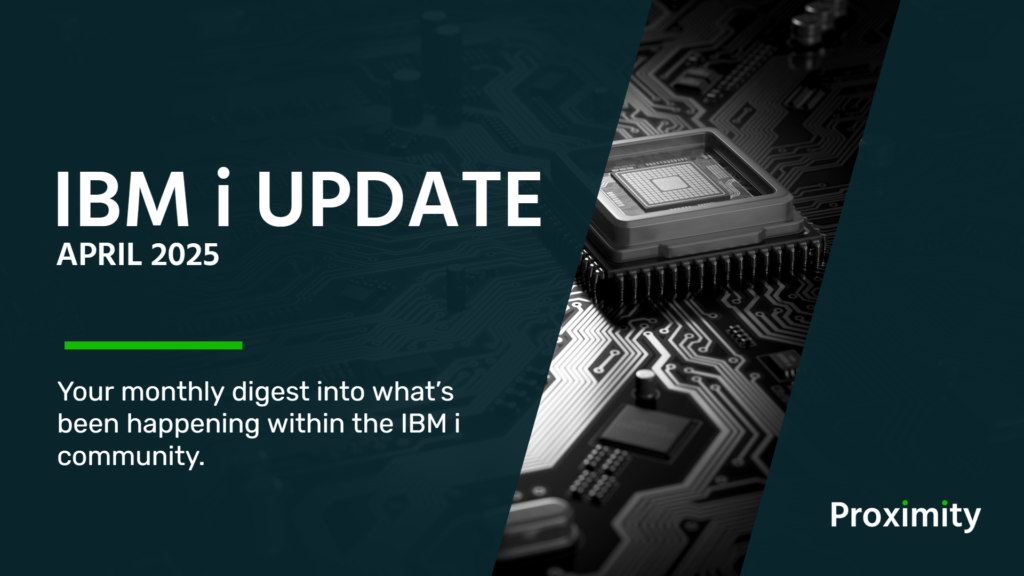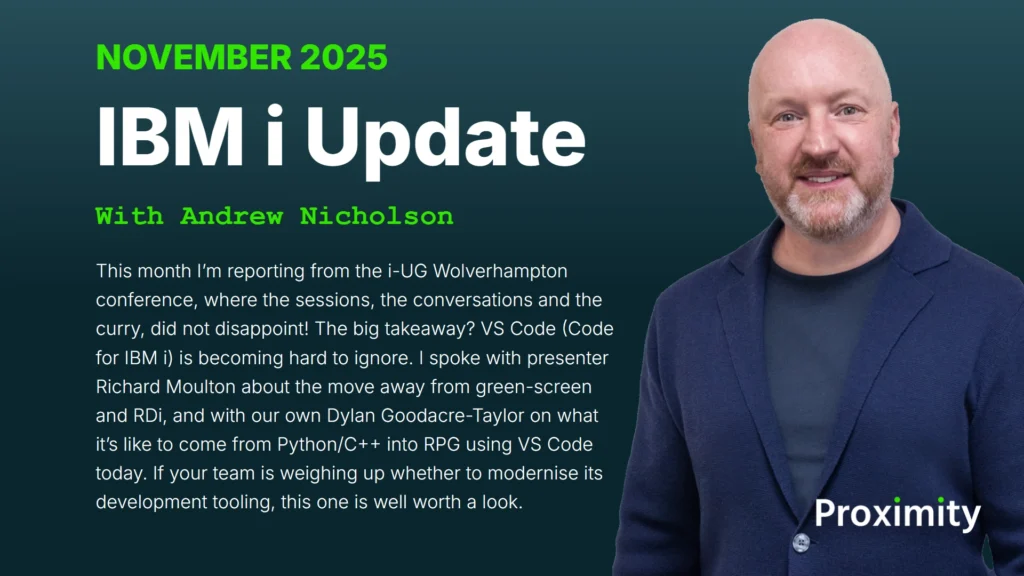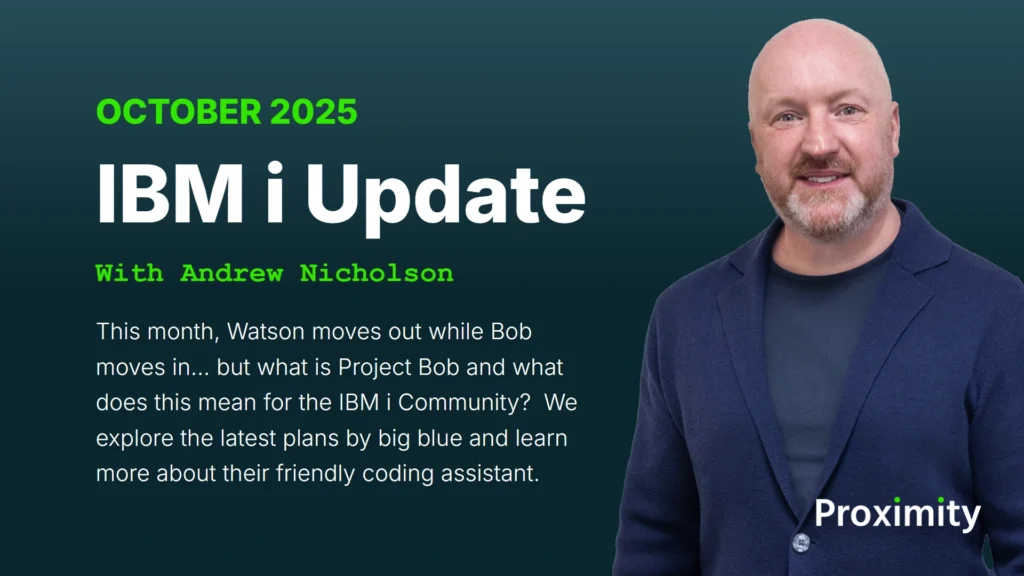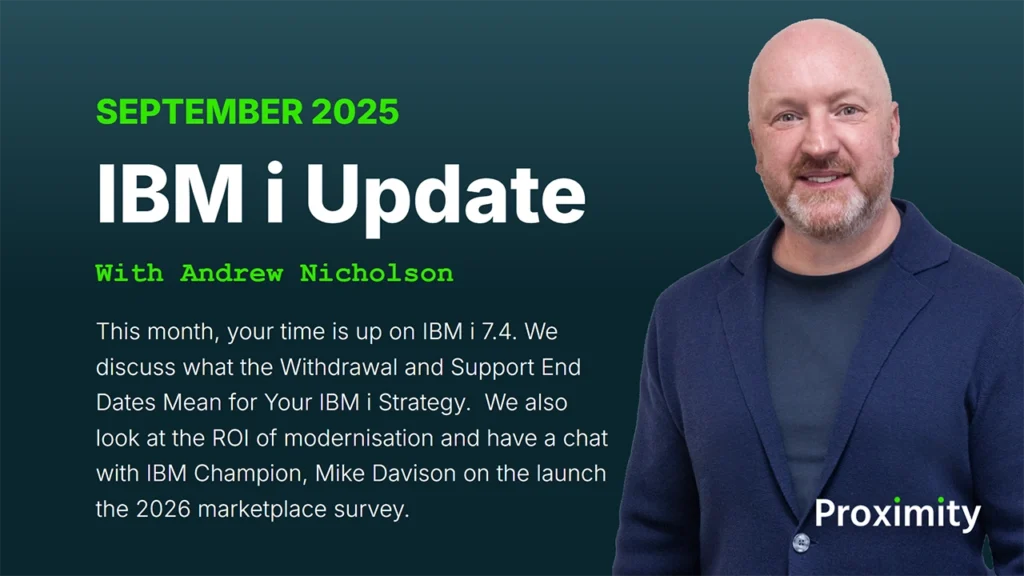Welcome to your IBM i update for April 2025 – a snapshot of news and views on what’s been happening in the IBM i community in the past few weeks as reported by Proximity.
This month we discuss the announcement on v7.6 of IBM i as provided by Steve Will on the 10th April. Elon Musk wants to use AI to replace COBOL in just four months – is it possible? And we speak with Fortra stalwart and IBM i Champion, Mike Davison on what we’ve learned from the IBM i Marketplace Survey.
You can watch the full interview with Mike here.
As for this month’s IBM i Update, you can watch the video below or read the full article underneath.
IBM i Next – Insights from Steve Will
On April 10th we enjoyed the IBM i Next presentation by IBM i’s Chief Technology Officer, Steve Will. Steve was joined by Steve Wolk and the Chief Technology Officer for PC Richard & Son and Steve Bradshaw, IBM i Champion, i-UGs Technical Director and all-round friendly techie.
Together the three Steve’s provided insights into the evolution of the platform and what’s coming next…
IBM i Version 7.6
And it was all about evolution rather than revolution as IBM i 7.6 was announced. In 7.6 we have some really neat updates in the latest version. But by far the most prominent, and perhaps most requested feature was with MFA.
MFA Announced in IBM i v7.6 to minimise vulnerabilities
This now fully integrated multi-factor authentication has been added to strengthens your security posture, providing robust defence against ransomware and unauthorised access while minimising vulnerabilities and protecting critical data.
On this, Steve Bradshaw said, “This is a wonderful tool. It is absolutely rock solid. It’s built into the core of the operating system… It’s actually easy deploy. We’re getting QR codes that you just scan in from your phone; a recovery code that you can copy and paste and store in your password vault of choice. So, IBM i looks like every other platform now when it comes to security. It’s inbuilt, It’s easy to collaborate with, and it is gosh darn secure!”
And while MFA is the real headline for 7.6, there were more enhancements to discuss.
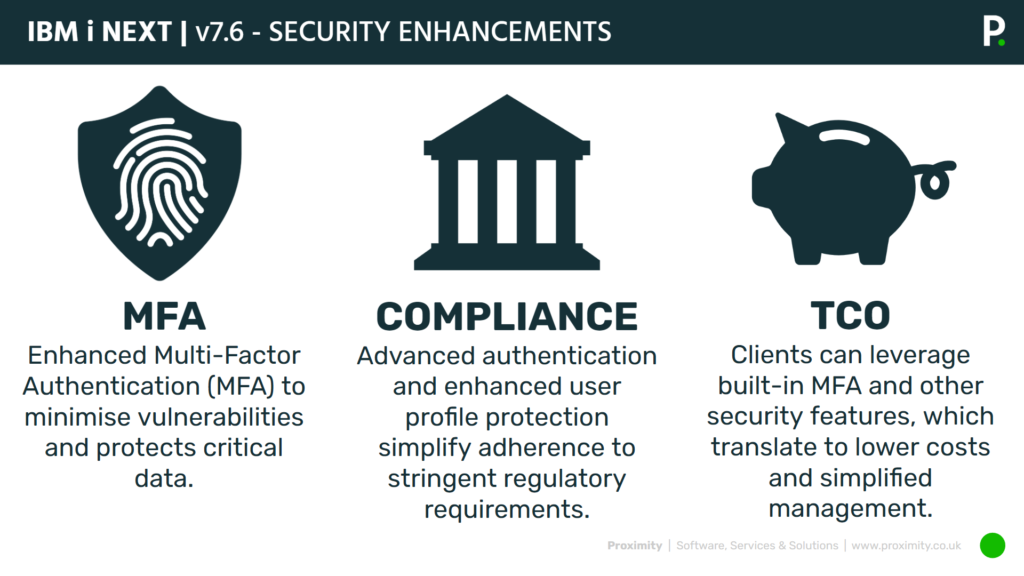
Streamlined regulatory compliance and lower Total Cost of Ownership (TCO)
Streamlined Regulatory Compliance (for example): This feature is to provide advanced authentication and enhanced user profile protection to simplify adherence to more stringent regulatory requirements.
And of course, should you leverage the built-in MFA and other security features, this translates to lower costs and simplified management thereby Reducing your Total Cost of Ownership (TCO).
Modern coding methodologies and techniques for the IBM i with Cryptographic services APIs
And there’s more… In Application development, IBM explained that they’ve delivered significant updates for developers to leverage modern methodologies and techniques and that there are new and updated cryptographic service APIs too to reinforce the enhancements in security.
And for System Administrators:
Navigator is fully updated and includes MFA in IBM i v7.6
Navigator for i is fully updated and now support MFA, providing secure remote management capabilities.
Back to Mr. Bradshaw, “So I’d really like to champion here the Navigator for i. I know it’s been around for a number of releases… but it is absolutely vital in today’s world. Now, it’s vital for two reasons. One, we’re always hearing about the skills gap and training new people up. I’m the same here. I’ve I’ve got a guy who’s been with me for just two weeks, coming fresh from university. On his second day, he was challenging me as to why this particular SSH service didn’t start automatically. Now, if I were to take him through the command line as to how to start, reconfigure that. It would have been a complicated process. He’d have had to take notes. In the Navigator interface, I literally hit Search, look for the service I’m after, right-click, Properties, Auto Start, check, done. I have someone who’s been on the job for two days that can now do a job that would have taken someone with a skilled interface and an understanding of a command line weeks to get to that point.”
Steve continued, “Now, this is just one example. That makes it intuitive and easy to use. But it’s also now starting to expose things that we never really needed to worry about before. Subscription licencing is here with many of us. To know when your licence keys are going to expire is absolutely vital. And guess where the place is that’s the best to be highlighted when you’ve got keys that are going to expire? It’s in the Navigator. The panes even change colour as you get close to it. This was an idea that came out of, I suspect, all three of those user groups saying, You need to do this. I really want to give a shout out to Tim and his team, and also Scott’s team for enabling these functions with the database calls underneath these services to make this a really easy to administer platform based on this graphical Navigator interface that’s on by default, installed by default, enabled by default, and fully MFA compliant.”
Proactive license management added in IBM v7.6
In addition, there’s now a proactive license management with license expiration information and warnings being more prominently displayed and so avoids disruptions while providing continuous operations.
Secure connection interfaces added in IBM i v7.6
And finally, we have Secure Connection Interfaces: There are new interfaces to facilitate secure connections to IBM i, simplifying system administration tasks.
So, for all those getting excited for v8 and power 11 announcement, get back behind the stable door. These were very much business as usual but progressive enhancements.
IBM i v7.6 Requirements and release date

And what do you need to run v7.6? Well, it’ll be supported on selected IBM Power servers with IBM Power 10 technology-based processors.
Set the date in your calendar as it’s planned availability is from the 18th April.
DOGE attempts to replace over 60 million lines of COBOL code at the SSA using AI
So, many of you may have noticed that there’s a situation unfolding in America, where a recently formed agency — the Department of Government Efficiency (DOGE) — is attempting to replace over 60 million lines of COBOL code at the Social Security Administration (SSA). To give you an idea of the importance of this code, every month, it reliably handles payments for over 65 million Americans.
According to Wired, DOGE’s plan is to swap COBOL for a modern language like Java in record time, aiming to complete the transition within just a few months. Now, COBOL’s been the engine behind SSA’s operations since the 1980s. It’s old, yes — but it works. And in systems this critical, “working” beats “shiny” every time.
The concern from industry veterans? Ripping out a system this complex without a clear and cautious migration plan could cause underpayments, overpayments, or missed payments altogether. As Wired points out, even small bugs could have catastrophic consequences.
However, Elon Musk thinks differently and suggests that AI will be the magic bullet for replacing COBOL. But is this poppycock or could this actually work? Well, since 2023, IBM have been championing WatsonX as a code assistant on Z to convert COBOL into Java. As an article in DevOps stated, this will not only convert code but it, ‘improves the syntax of Java code generated using object-oriented techniques’. So, a positive step right? Well, there are other considerations. As while AI can help modernise COBOL (with documentation, code conversion and test generation), it doesn’t dissect or decodes decades worth of business or edge case logic, edge or weird data or process workarounds that have been bespoked and then bespoked some more for particular rules or requirements. These things are hard to replicate and are easily missed during rewrites when just the code is considered.
So, the problems aren’t just about the language. It’s the assumptions behind the migration. COBOL systems like the SSA’s are deeply interwoven with business rules, legacy databases, and decades of operational reality. Any modernisation effort that skips discovery, testing, and validation is just asking for trouble.
You need the skilled developers to translate the intent behind the code, not just the syntax. As Heise reported, experts are questioning the timeline, the methods, and the lack of contingency. Because let’s face it — you can’t just throw ChatGPT at 60 million lines of COBOL and call it a day. And with this in mind, this supposed four month project is more likely to take four plus years.
However, it’s great to see attention on legacy modernisation — we’ve been championing just this in the IBM i community for years. But modernisation isn’t all about speed. It’s about understanding.
So, Elon Musk says AI will replace COBOL. Maybe one day. But for now, AI’s role is more apprentice than architect — it can help guide the rebuild, but it still needs experienced developers to make sure the roof doesn’t cave in.
Reviewing the IBM i Marketplace Survey 2025 with Mike Davison from Fortra
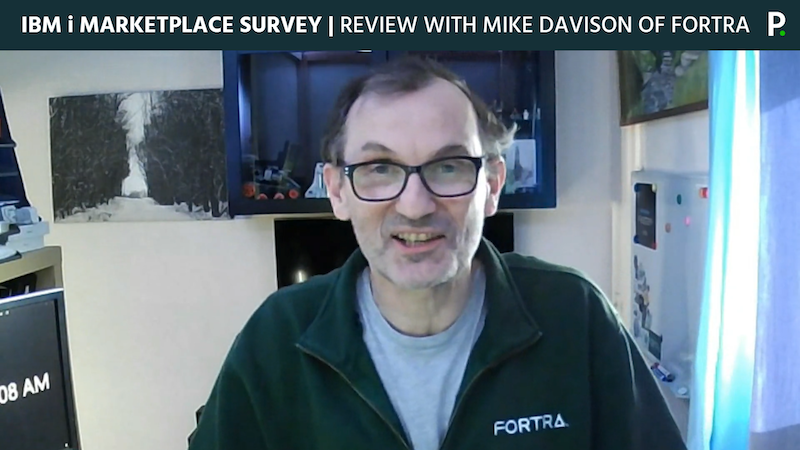
Finally, I met with IBM i Champion and Fortra Stalwart, Mike Davison to discuss the recent Fortra IBM i Marketplace Survey and asked, what did we learn from the results…
Watch the full un-edited interview here
And that’s it for this month’s update. For more like this, please see our blog on the proximity website, but for now, I’m Andrew Nicholson, we’re Proximity, your IBM i partner for application development, support and maintenance.
We’ll see you next time, goodbye.
Catch our previous February & March 2025 IBM i Update here. We’ve also got a summary of all the IBM i Updates published in 2024 here.
Alternatively, if you’d like to receive the latest IBM i Update hot off the press to your inbox, subscribe to the newsletter version on LinkedIn.

